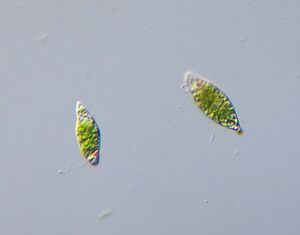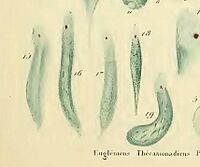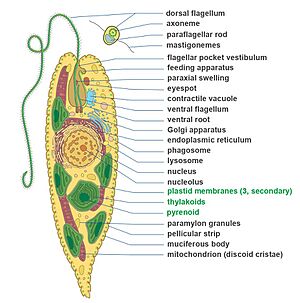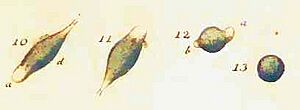Euglena facts for kids
Quick facts for kids Euglena |
|
|---|---|
 |
|
| Euglena sp. | |
| Scientific classification |
|
| Unrecognized taxon (fix): | Euglena |
Euglena is a tiny, single-celled living thing. It is a type of eukaryote, which means its cell has a special control center called a nucleus. Euglena is well-known because it can act like both a plant and an animal!
You can find Euglena in both fresh and salt water. They often live in calm waters like ponds and ditches. Sometimes, there are so many Euglena that they make the water look green (like E. viridis) or even red (like E. sanguinea).
One type, Euglena gracilis, is often used in science labs to learn more about how cells work.
Most Euglena have special parts called chloroplasts inside their bodies. These chloroplasts let them make their own food using sunlight, just like plants do. This way of eating is called autotrophy. But Euglena can also get food from their surroundings, like animals do. This is called heterotrophy.
Because Euglena has features of both plants and animals, early scientists found them hard to classify. This led to the idea of adding a new group, the Kingdom Protista, for these unique creatures.
Contents
How Euglena Works
When Euglena eats like an animal, it takes in nutrients from its surroundings. It can live without light if it has organic matter to eat, like sugars or other food bits.
When there is enough sunlight, Euglena uses its chloroplasts to make food. These chloroplasts contain green pigments called chlorophyll a and chlorophyll b. They use these to create sugars through a process called photosynthesis.
Interestingly, Euglenas chloroplasts have three membranes around them. Plant chloroplasts only have two. Scientists think this means Euglenas chloroplasts came from a different type of green alga a long, long time ago. This is an example of something called endosymbiosis.
Euglena chloroplasts also have something called pyrenoids. These are used to store energy as a type of starch called paramylon. This stored energy helps Euglena survive when there isn't enough light. The presence of pyrenoids helps scientists tell Euglena apart from other similar organisms.
Euglena has two whip-like tails called flagella. These are attached at the front of its body. Usually, one flagellum is very short and stays inside the cell. The other is long and can be seen with a microscope. This long flagellum helps the Euglena swim. The surface of the flagellum has tiny, fine hairs called mastigonemes.
Like other similar organisms, Euglena has a red eyespot. This eyespot is made of colored granules. The red spot itself doesn't see light. Instead, it acts like a filter. It helps control how much sunlight reaches a light-detecting part at the base of the flagellum. This allows Euglena to find light and move towards it, a process called phototaxis.
Euglena does not have a hard cell wall like plants. Instead, it has a flexible outer layer called a pellicle. This pellicle is made of protein strips that spiral around the cell. These strips can slide over each other, which gives Euglena its amazing flexibility. This movement is called metaboly. It lets Euglena change its shape and squeeze through tight spaces.
When there isn't enough water or food, Euglena can form a protective wall around itself. It then goes into a resting state, like sleeping, until conditions get better.
Reproduction
Euglena reproduce without a partner. They do this through a process called binary fission, which is a type of cell division. First, the cell nucleus divides. Then, the cell itself splits in half lengthwise. This splitting starts at the front of the cell and slowly moves to the back until two completely separate Euglena are formed.
Discovery and Naming
Euglena was one of the first tiny organisms seen under a microscope. In 1674, a Dutch scientist named Antonie van Leeuwenhoek described tiny "animalcules" that were green in the middle. Scientists believe these were likely Euglena viridis.
Later, in 1786, O.F. Müller gave a more complete description of the organism. He named it Cercaria viridis and drew pictures showing how it could change its body shape.

In 1830, C. G. Ehrenberg renamed Müller's Cercaria to Euglena viridis. He noticed Euglena's eyespot and thought it was a simple eye. The name Euglena comes from Greek words meaning "well" and "eyeball."
Ehrenberg didn't see Euglena's flagella, though. The first person to describe these whip-like tails was Félix Dujardin in 1841. Because of its flagella, Euglena was later placed in a group called Flagellata.
Modern Classification
For a long time, scientists classified Euglena based on whether they were green (photosynthetic) or colorless (heterotrophic). However, by the 1950s, scientists realized this wasn't the best way. They started grouping organisms based on shared physical features, like the number and type of flagella.
In 1994, genetic studies showed that even colorless Euglena-like organisms had DNA from ancestors that used to have chloroplasts. This proved that the old way of classifying them was not accurate.
More recent studies using DNA analysis have helped scientists understand the true relationships between different Euglena species and their relatives. They found that some species once thought to be different were actually very closely related. This has led to a more accurate way of classifying these amazing single-celled creatures.
Uses of Euglena
Euglena is being explored for several interesting uses:
- Food: Powdered Euglena has a taste like dried sardines. It contains minerals, vitamins, and healthy omega-3 fats. It can be used as an ingredient in other foods.
- Biofuel: The fats inside Euglena can be used to make biodiesel and jet fuel. A company in Japan has even built a plant to produce biofuel from Euglena.
See also
 In Spanish: Euglena para niños
In Spanish: Euglena para niños
- Elysia chlorotica
- Kleptoplasty





